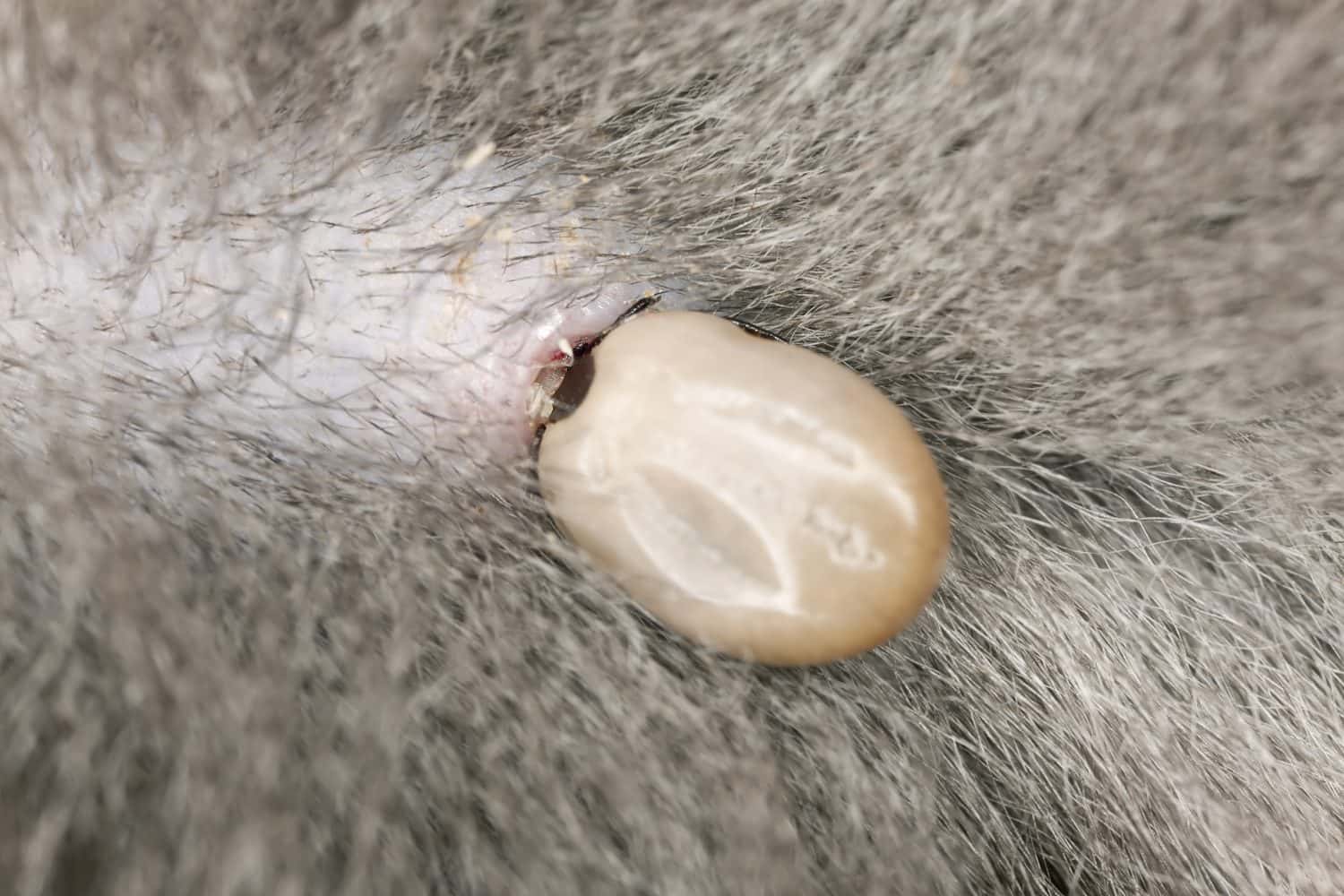A common fear for pet parents when the weather warms up is the possibility of your furry friend having a tick. ticks are small blood-sucking parasites that can bring a myriad of dangerous diseases to your cat. Thankfully, there are several natural ways to get rid of ticks on your cat.

Be sure to check your cat each day, even if they don’t spend time outside. You would be surprised how easily these pests make their way indoors.
1. Vinegar

White vinegar is considered safe for cats.
©focal point/Shutterstock.com
Starting our list off right is the use of vinegar. Vinegar contains an ingredient called acetic acid. This is what gives vinegar its notably sour taste. Luckily, ticks despise this substance. When a tick comes in contact with acetic acid from vinegar, it will leave its host animal to avoid any potential interaction with it.
That being said, you wouldn’t want to just douse your cat with vinegar. There are a few different ways you can apply this common household good to naturally repel ticks from your cat. You can pour a mixture of equal parts water and vinegar on a clean towel.
Lightly massage your pet with it, making sure to get deep into the fur. Avoid placing this mixture anywhere near your pet’s eyes or ears. Because ears are a common spot for ticks to hide, you’ll have to do a thorough check using your eyes and hands only.
You could also mix vinegar with your cat’s shampoo. All this requires is bathing your cat with the mixture and drying them with a towel. You don’t have to pull off the tick yourself, as they should leave themselves due to their distaste for the acetic acid.
2. Almond Oil

You can get almond oil online and in many grocery stores.
©Owl_photographer/Shutterstock.com
Another effective and natural method for repelling ticks from your feline friend is to use almond oil. This oil has many incredible benefits, including moisturizing your pet’s skin and even healing the area from a tick bite.
To use this method you’ll want to combine 20 ml of almond oil with a single vitamin E capsule. Don’t worry; you can use the almond oil alone if you don’t have any vitamin E capsules. Take a towel and soak it with the almond oil mixture.
Rub the cloth directly over any tick you find on your cat. It shouldn’t take long for the pest to fall off on its own. This method is best for ticks that are around the eyes, ears, or on the paws.
3. Olive Oil

Olive oil promotes fur health in cats and dogs.
©Dusan Zidar/Shutterstock.com
Another kitchen staple that you likely already own that can help to naturally remove ticks from a cat is olive oil. You’ll want to take a piece of gauze and pour a bit of extra virgin olive oil onto it. Lightly tap the tick with the oil-infused gauze.
The parasite will eventually detach itself from the skin and leave completely. You’ll want to be sure but you get rid of the tick and dispose of it to ensure it won’t bite you or your pet again. Similar to almond oil, olive oil will help to regenerate the skin that has been bitten.
4. Tweezers

There are roughly 900 species of ticks.
©Jay Ondreicka/Shutterstock.com
To take matters into your own hands, add tweezers to the mix. You can either use tweezers by itself or in addition to any of the natural repellents we’ve listed so far. This is a sure-fire way to dispose of the tick immediately and know for sure that it is no longer on your feline friend.
When you’re doing this, you want to make sure that the tweezers are as close to the tick’s mouth as possible. You do not want any of the ticks’ heads to remain inside of your cat. This can lead to dangerous health issues.
When you have the tweezers in the right spot, gently pull upwards. Be sure to not twist or make any sudden movements. Once you dispose of the tick, make sure you disinfect the area with something like rubbing alcohol.
5. Chamomile

Chamomile is often used in pet products to help them calm down.
©George Dolgikh/Shutterstock.com
There’s no denying that kittens are more likely to get diseases than cats that are fully developed. If you find a tick on a kitten’s body, it is essential that you remove it as quickly as possible. One of the best things you can do is utilize chamomile.
Chamomile is packed with essential anti-inflammatory, antiseptic, and other healing agents. It is not toxic to your pet and will help the skin regenerate quickly. To utilize this method, prepare a cup of organic chamomile.
Once it’s cool enough, soak a piece of gauze, and lightly rub the area where the tick is attached. While the tick should leave on its own, you can use tweezers to finish it yourself.
6. Vaseline

A tick that has been on your cat for a long time will be engorged and grey in color.
©Henrik Larsson/Shutterstock.com
If you spot a tick on your feline friend, consider taking a trip to your medicine cabinet. Vaseline or petroleum jelly can get rid of ticks effectively and naturally. Grab a cotton swab and place a small dollop of petroleum jelly on one end.
Rub it around the spot where the tick is attached. It will eventually release its grip due to suffocation. Again, like the other methods, you want to be sure that you dispose of the tick after it’s removed.
The photo featured at the top of this post is © Eric Isselee/Shutterstock.com
Thank you for reading! Have some feedback for us? Contact the AZ Animals editorial team.







